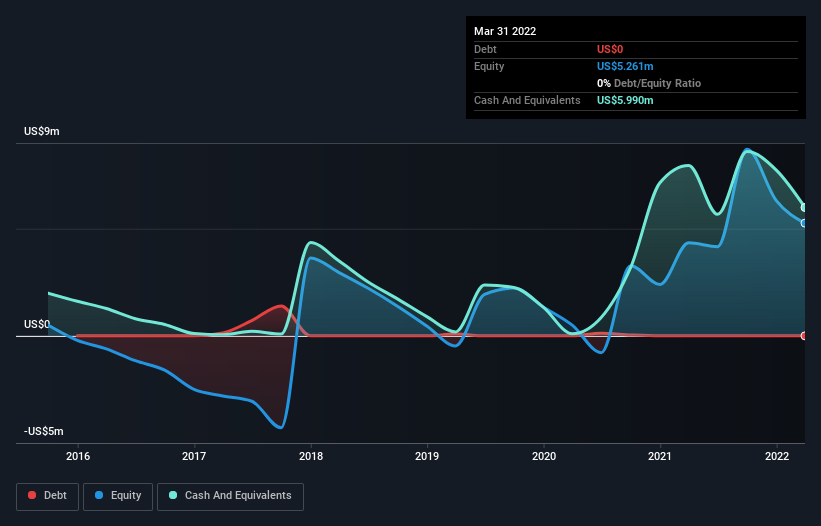Even when a business is losing money, it's possible for shareholders to make money if they buy a good business at the right price. For example, biotech and mining exploration companies often lose money for years before finding success with a new treatment or mineral discovery. Nonetheless, only a fool would ignore the risk that a loss making company burns through its cash too quickly.
So, the natural question for NanoVibronix (NASDAQ:NAOV) shareholders is whether they should be concerned by its rate of cash burn. In this article, we define cash burn as its annual (negative) free cash flow, which is the amount of money a company spends each year to fund its growth. Let's start with an examination of the business' cash, relative to its cash burn.
See our latest analysis for NanoVibronix
Does NanoVibronix Have A Long Cash Runway?
A cash runway is defined as the length of time it would take a company to run out of money if it kept spending at its current rate of cash burn. In March 2022, NanoVibronix had US$6.0m in cash, and was debt-free. Looking at the last year, the company burnt through US$5.2m. So it had a cash runway of approximately 14 months from March 2022. While that cash runway isn't too concerning, sensible holders would be peering into the distance, and considering what happens if the company runs out of cash. You can see how its cash balance has changed over time in the image below.

How Is NanoVibronix's Cash Burn Changing Over Time?
In our view, NanoVibronix doesn't yet produce significant amounts of operating revenue, since it reported just US$1.9m in the last twelve months. Therefore, for the purposes of this analysis we'll focus on how the cash burn is tracking. Over the last year its cash burn actually increased by 49%, which suggests that management are increasing investment in future growth, but not too quickly. That's not necessarily a bad thing, but investors should be mindful of the fact that will shorten the cash runway. Of course, we've only taken a quick look at the stock's growth metrics, here. You can take a look at how NanoVibronix is growing revenue over time by checking this visualization of past revenue growth.
How Hard Would It Be For NanoVibronix To Raise More Cash For Growth?
Given its cash burn trajectory, NanoVibronix shareholders may wish to consider how easily it could raise more cash, despite its solid cash runway. Companies can raise capital through either debt or equity. One of the main advantages held by publicly listed companies is that they can sell shares to investors to raise cash and fund growth. By looking at a company's cash burn relative to its market capitalisation, we gain insight on how much shareholders would be diluted if the company needed to raise enough cash to cover another year's cash burn.
NanoVibronix has a market capitalisation of US$21m and burnt through US$5.2m last year, which is 25% of the company's market value. That's fairly notable cash burn, so if the company had to sell shares to cover the cost of another year's operations, shareholders would suffer some costly dilution.
Is NanoVibronix's Cash Burn A Worry?
Even though its increasing cash burn makes us a little nervous, we are compelled to mention that we thought NanoVibronix's cash runway was relatively promising. Summing up, we think the NanoVibronix's cash burn is a risk, based on the factors we mentioned in this article. On another note, NanoVibronix has 5 warning signs (and 1 which doesn't sit too well with us) we think you should know about.
If you would prefer to check out another company with better fundamentals, then do not miss this free list of interesting companies, that have HIGH return on equity and low debt or this list of stocks which are all forecast to grow.
Valuation is complex, but we're here to simplify it.
Discover if NanoVibronix might be undervalued or overvalued with our detailed analysis, featuring fair value estimates, potential risks, dividends, insider trades, and its financial condition.
Access Free AnalysisHave feedback on this article? Concerned about the content? Get in touch with us directly. Alternatively, email editorial-team (at) simplywallst.com.
This article by Simply Wall St is general in nature. We provide commentary based on historical data and analyst forecasts only using an unbiased methodology and our articles are not intended to be financial advice. It does not constitute a recommendation to buy or sell any stock, and does not take account of your objectives, or your financial situation. We aim to bring you long-term focused analysis driven by fundamental data. Note that our analysis may not factor in the latest price-sensitive company announcements or qualitative material. Simply Wall St has no position in any stocks mentioned.
About NasdaqCM:NAOV
NanoVibronix
Through its subsidiaries, focuses on non-invasive biological response-activating devices that target biofilm prevention, pain therapy, wound healing, and at home administration without medical professional assistance.
Flawless balance sheet with slight risk.
Similar Companies
Market Insights
Community Narratives




